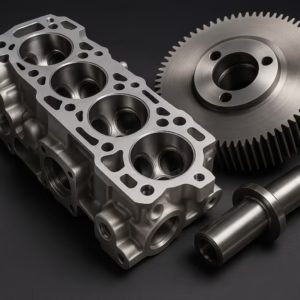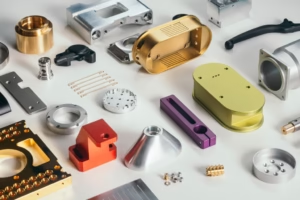Eigenschaften und Anwendungen von Titan-Legierungen
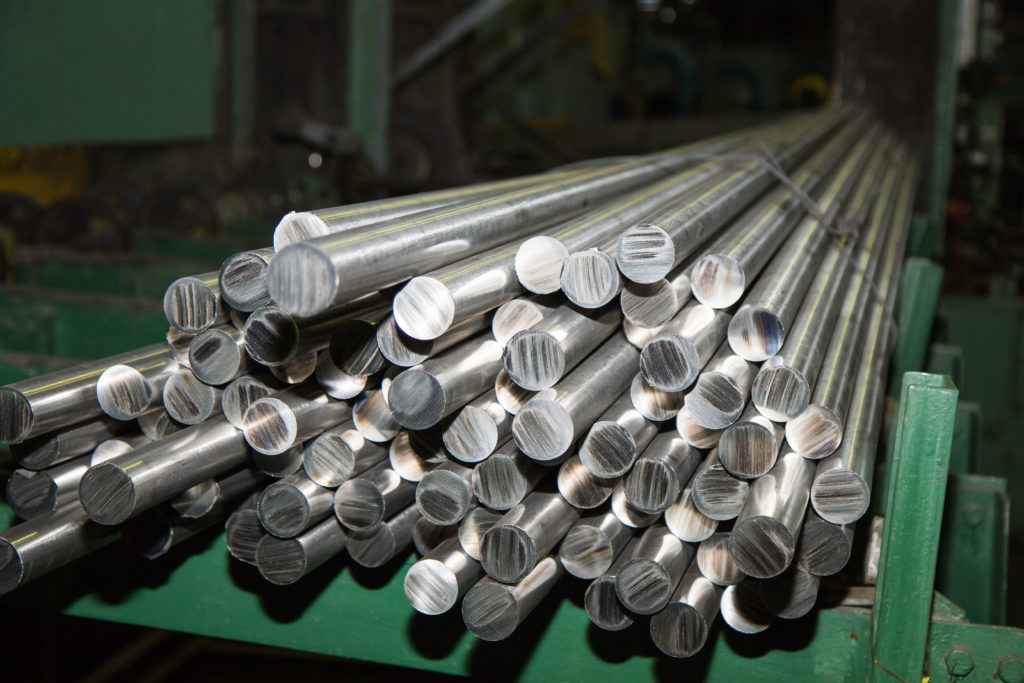
Blog Details In 1948, the United States DuPont Company used the magnesium method to produce tons of titanium sponge – this marks the beginning of the industrial production of titanium sponge titanium, and titanium alloy is widely used in various fields because of its high specific strength, good corrosion resistance and high heat resistance. Titanium alloys have been used in aviation for more than half a century. In the 3C field, many mobile phones have been imported into the material, and more and more manufacturers are expected to use titanium alloy. So why is titanium alloy so popular? Properties of Titanium Alloys High strength: 1.3 times of aluminum alloy, 1.6 times magnesium alloy, and 3.5 times of stainless steel, the champion of metal materials. High thermal strength: the use temperature is several hundred degrees higher than aluminum alloy, and it can work for a long time at a temperature of 450 ~ 500 C. Good corrosion resistance: acid resistance, alkali resistance, atmospheric corrosion resistance, pitting corrosion, and stress corrosion resistance are particularly strong. Good low-temperature performance: Titanium alloy TA7 with deficient gap elements can maintain a certain plasticity at -253 ° C. High chemical activity: high chemical activity at high temperatures, easily reacts with gas impurities such as hydrogen and oxygen in the air to generate a hardened layer. The thermal conductivity is small, the elastic modulus is small: the thermal conductivity is about 1/4 of nickel, 1/5 of iron, 1/14 of aluminum, and the thermal conductivity of various titanium alloys is about 50% lower than the thermal conductivity of titanium. The elastic modulus of titanium alloy is about 1/2 that of steel. Classification and use of titanium alloys Titanium alloys can be divided into heat-resistant alloys, high-strength alloys, corrosion-resistant alloys (titanium-molybdenum, titanium-palladium alloys, etc.), low-temperature alloys, and special functional alloys (titanium-iron hydrogen storage materials, titanium-nickel memory alloys). Although the history of titanium and its alloys is not long, it has won several honorable titles because of its extraordinary properties. The first won title is “space metal”, it is lightweight, has a specific strength, and high-temperature resistance, especially suitable for the manufacture of aircraft and various spacecraft. About three-quarters of the world’s production of titanium and titanium alloys are used in the aerospace industry. Many parts originally made of aluminum alloy have been converted to titanium alloy. 3. Analysis of machining characteristics of titanium alloy First of all, the thermal conductivity of titanium alloy is low, only 1/4 of steel, 1/13 of aluminum, and 1/25 of copper. Due to the slow heat dissipation of the cutting zone, which is not conducive to the heat balance, in the cutting process, the heat dissipation and cooling effect is very poor, easy to form high temperatures in the cutting zone, and the deformation and rebound of the parts after processing is large, increasing by cutting tool torque, fast cutting edge wear and reduced durability. Secondly, the thermal conductivity of titanium alloy is low, so the cutting heat accumulation in the small area near the cutting tool is not easy to distribute, the front tool surface friction is increased, it is not easy to remove chips, the cutting heat is not easy to distribute, and the tool wear is accelerated. Finally, the chemical activity of titanium alloy is high, and it is easy to react with the tool material at high temperatures, forming dissolution and diffusion, resulting in the phenomenon of sticking, burning, and breaking the knife. Machining center processing titanium alloy characteristics The machining center can process multiple parts simultaneously to improve production efficiency. Improve the machining accuracy of parts, product consistency is good. The machining center has the tool compensation function, which can obtain the machining accuracy of the machine tool itself. It has a wide range of adaptability and greater flexibility, such as the arc processing of the part, chamfering, and transition rounding, which can achieve multiple functions of one machine. Machining centers can be milling, drilling, boring, tapping, and a series of processing. Accurate costing can be performed to control the production schedule. Do not need special fixtures, save a lot of cost funds, and shorten the production cycle. Greatly reduce the labor intensity of workers. Multi-axis machining can be done with UG and other machining software. Prototek has been offering professional custom CNC machining parts for over 13 years. If you have any needs about metal manufacturing services, contact us via email: Lynnyao@prototekparts.com or phone: +86-0792-86372550 Tags: Social Network: Recently Posts Online Help! +(86) 0791-86372550 WANT TO DISCUSS IN DETAIL Contact Our Consultant Now CONTACT NOW
Auspufftopf für die Klimaanlage eines Autos
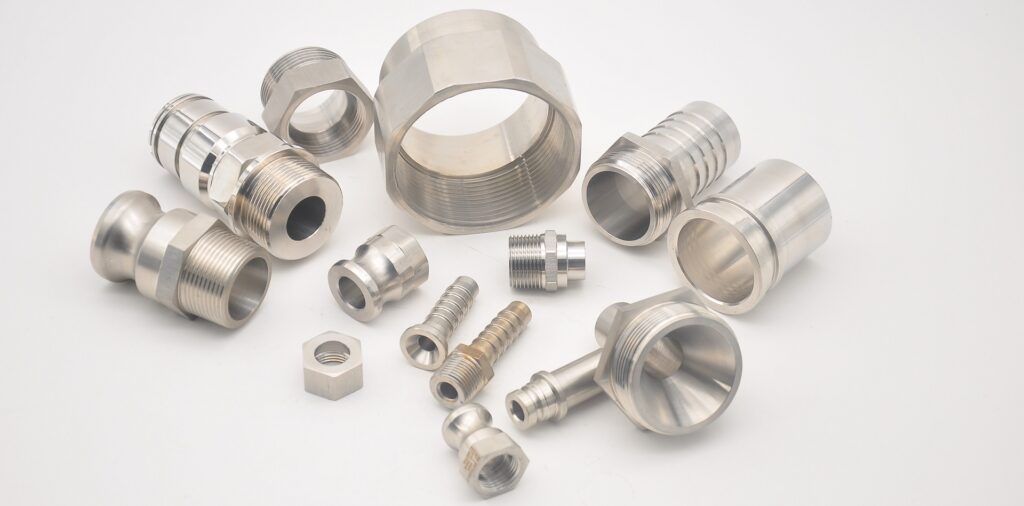
Blog Details Automobile air conditioner mufflers are an important component of a vehicle’s air conditioning system. They are designed to reduce the noise produced by the air conditioning unit, ensuring a comfortable and quiet ride for passengers. The air conditioning unit in a vehicle works by compressing refrigerant gas, which creates heat and noise. The muffler is attached to the outlet of the compressor and is responsible for dissipating this heat and noise. Mufflers are typically made of metal or other heat-resistant materials and have a series of internal chambers and passages. These passages allow the compressed gas to flow through and cool down, while also dampening the sound produced by the compressor. Mufflers are crucial for the proper functioning of a vehicle’s air conditioning system. Without a muffler, the compressor would produce excessive heat and noise, making the air conditioning unit less effective and potentially damaging other components in the system. In addition to their noise-dampening properties, mufflers also serve a critical safety function. High levels of heat and pressure can build up in the compressor, which can lead to explosions or fires if not properly dissipated. The muffler helps to prevent these dangerous situations by releasing the heat and pressure in a controlled manner. Mufflers are typically made to last for the lifetime of a vehicle’s air conditioning system. However, they can become damaged or clogged over time, leading to reduced performance and potentially dangerous situations. Regular maintenance and inspections are recommended to ensure that the muffler is in good working condition. In the event that a muffler needs to be replaced, it is important to choose a high-quality replacement. Cheap, low-quality mufflers may not offer the same level of noise reduction or safety as OEM or aftermarket mufflers designed specifically for a vehicle’s air conditioning system. Overall, automobile air conditioner mufflers are a crucial component of a vehicle’s air conditioning system. They provide noise reduction and safety, ensuring a comfortable and safe ride for passengers. Regular maintenance and inspections are recommended to ensure that the muffler is in good working condition, and high-quality replacements should be used in the event of damage or wear. Prototek offering professional custom CNC machining parts over 13 years. If you have any needs about metal manufacturing services, , contact us via email: Lynnyao@prototekparts.com or phone: +86-0792-86372550 Tags: Social Network: Recently Posts Online Help! +(86) 0791-86372550 WANT TO DISCUSS IN DETAIL Contact Our Consultant Now CONTACT NOW
Erkunden Sie die Welt der CNC-Bearbeitung von Teilen

Blog Details In a world where precision and customization are paramount, the art of custom CNC machining parts stands above the rest. From aerospace to automotive industries, these intricate components play a crucial role in creating efficient and high-performance machinery. Every screw, every bolt, every gear is meticulously crafted with precision using state-of-the-art CNC (Computer Numerical Control) machining technology. This advanced process allows for the production of parts with impeccable accuracy, tight tolerances, and intricate designs. Custom CNC machining offers endless possibilities for manufacturers and businesses seeking to create unique and tailored solutions. Whether it’s prototyping, product development, or mass production, CNC machining provides the flexibility to bring ideas to life with unparalleled precision. With the ability to work with various materials, including metals, plastics, and composites, custom CNC machining parts can be used across a wide range of industries. From complex medical devices to intricate electronics, these parts optimize functionality, durability, and performance. Join us on a journey as we explore the exciting world of custom CNC machining parts and discover how these precision-engineered components are revolutionizing industries and driving innovation forward. Advantages of custom CNC machining parts Custom CNC machining parts offer numerous advantages over traditional manufacturing methods. One of the key benefits of CNC machining is its ability to produce highly accurate and consistent parts. The use of computer-controlled machines eliminates human error, resulting in parts that meet exact specifications every time. Another advantage of custom CNC machining parts is their versatility. CNC machines can work with a wide range of materials, including metals, plastics, and composites. This flexibility allows manufacturers to create parts that are suitable for various applications and industries. Additionally, CNC machining parts can be produced at a faster rate compared to other manufacturing processes. The automated nature of CNC machines enables continuous operation, reducing production time and increasing efficiency. This is especially beneficial for businesses with tight deadlines and high-volume production requirements. The process of custom CNC machining The process of custom CNC machining involves several steps to transform a design into a physical part. It begins with the creation of a 3D model using computer-aided design (CAD) software. The model is then converted into a program that the CNC machine can understand. Once the program is ready, the material is loaded onto the machine. The CNC machine uses various tools, such as drills, mills, and lathes, to shape the material according to the programmed instructions. The machine precisely moves along the X, Y, and Z axes, removing excess material and creating the desired shape. Throughout the machining process, operators monitor the machine’s progress and make any necessary adjustments. After the part is machined, it undergoes post-processing, which may include deburring, polishing, or surface treatment, to achieve the desired finish. Materials used in custom CNC machining parts Custom CNC machining parts can be made from a wide range of materials, depending on the specific requirements of the application. Metals such as aluminum, steel, brass, and titanium are commonly used for their strength, durability, and heat resistance. Plastics, including ABS, acrylic, and nylon, are also popular choices due to their lightweight properties and ease of machining. These materials are often used in industries such as electronics and consumer goods, where weight reduction and cost-effectiveness are important factors. In addition to metals and plastics, custom CNC machining can also be performed on composites, such as carbon fiber and fiberglass. These materials offer a high strength-to-weight ratio and are commonly used in industries such as aerospace and automotive, where weight reduction is critical for performance optimization. Applications of custom CNC machining parts Custom CNC machining parts find applications in a wide range of industries, revolutionizing the way products are designed and manufactured. In the aerospace industry, CNC machining is used to create complex components for aircraft and spacecraft, ensuring high performance and reliability. The automotive industry also benefits greatly from custom CNC machining parts. CNC machines are used to manufacture engine components, transmission parts, and intricate interior and exterior components. The precision and durability of CNC machining parts contribute to the overall quality and performance of vehicles. The medical industry relies on custom CNC machining parts for the production of surgical instruments, implants, and medical devices. CNC machining ensures that these parts meet strict quality standards and are compatible with the human body. Other industries that benefit from custom CNC machining parts include electronics, defense, energy, and telecommunications. CNC machines are used to create intricate circuit boards, housing components, energy generation equipment, and communication devices, among others. Factors to consider when choosing a CNC machining service provider When choosing a CNC machining service provider, several factors should be taken into consideration to ensure a successful partnership. First and foremost, the experience and expertise of the service provider are crucial. Look for a company that has a proven track record in delivering high-quality CNC machining parts and has experience working with the specific materials and industries relevant to your project. Another important factor to consider is the capabilities and capacity of the CNC machining facility. Make sure the service provider has the necessary equipment, tools, and technologies to meet your project requirements. Additionally, consider the production capacity of the facility to ensure that they can handle your order volume within the desired timeline. Quality control and inspection processes should also be a priority when choosing a CNC machining service provider. Look for a company that has stringent quality control measures in place to ensure that each part meets the required specifications. This can include regular inspections, testing, and certifications to guarantee the highest level of quality. Examples of industries that benefit from custom CNC machining parts Custom CNC machining parts have a significant impact on various industries, enabling enhanced performance, improved efficiency, and innovative designs. One industry that greatly benefits from CNC machining is the aerospace industry. From turbine blades to landing gear components, CNC machining allows for the creation of complex and lightweight parts that meet the strict standards of the aerospace industry. The automotive
How New Energy Vehicles Work ?

Blog Details 1. New energy vehicles are vehicles that use non-petroleum derivatives as power. The working principle of ordinary vehicles is the process of converting thermal energy into mechanical energy by the engine, through four continuous processes of intake, compression, work and exhaust. Realized, each time such a process is called a work cycle. And new energy vehicles work in different ways according to their power. 2. The working principle of hybrid cars and hydrogen engine cars is the same as that of ordinary cars. 3. Fuel cell electric vehicles are used by hydrogen and oxygen in hydrogen and air under the action of catalysts, and electrical energy generated by electrical chemical reactions in fuel cells as the main power source driver. Fuel cell electric vehicles are essentially a kind of pure electric vehicle, which is mainly different from the working principle of dry power batteries. Generally speaking, fuel cells are transformed into electrical energy through electrochemical reactions. The reducing agent required for electrochemical reactions is generally hydrogen, and oxidants use oxygen. Therefore the storage of hydrogen can be stored in the form of liquefied hydrogen, hydrogen or metal hydrogen storage. 4. Pure electric vehicles are a car that uses a single-storage battery as a source of energy storage power. It uses battery as a source of energy storage power and provides electric energy to the motor through the battery to drive the motor to drive the vehicle. 5. Other new energy vehicles include cars using high -efficiency reservoirs such as supercapacitors and flywheels. At present, new energy vehicles mainly refer to pure electric vehicles, extended electric vehicles, plug-in hybrid vehicles and fuel cell electric vehicles. Conventional hybrid vehicles are divided into energy-saving vehicles. 6. From the perspective of the development of global new energy vehicles, its power power supply mainly includes lithium-ion batteries, nickel-metal hydride batteries, fuel cells, lead-acid batteries, and supercapacitors. Most of the supercapacitors appear in the form of auxiliary power sources. If you have any auto parts needs, contact us via email: Lynnyao@prototekparts.com or WhatsApp: +86-0792-86372550 Tags: Social Network: Recently Posts Online Help! +(86) 0791-86372550 WANT TO DISCUSS IN DETAIL Contact Our Consultant Now CONTACT NOW
Wie viel wissen Sie über Metallguss?
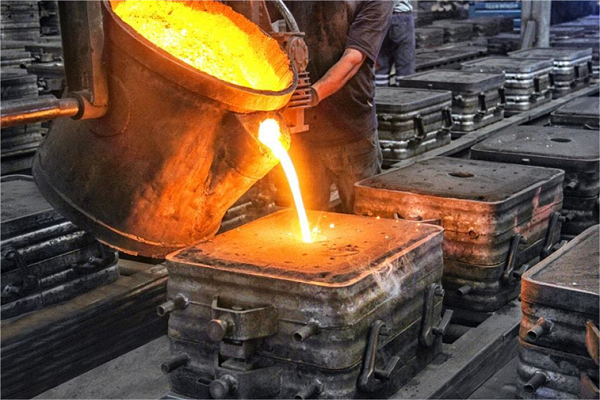
Blog Details Metal casting involves pouring molten metal into a mold cavity, where it solidifies and takes the shape of the mold. The most commonly used metals for casting are: Iron: Cast iron is a strong, brittle material that is commonly used in applications that require strength and wear resistance, such as engine blocks, pipes, and gears. Steel: Steel is a versatile material that can be cast into a wide range of shapes and sizes. It is commonly used in automotive and aerospace applications, as well as in construction. Aluminum: Aluminum is a lightweight, corrosion-resistant metal that is commonly used in casting applications that require strength and durability, such as engine blocks, wheels, and transmission cases. Copper and Brass: Copper and brass are often used in casting applications that require good thermal and electrical conductivity, such as electrical components and heat exchangers. Zinc: Zinc is a low-melting-point metal that is commonly used in die-casting applications for small, complex parts such as gears, connectors, and housings. Other metals occasionally used in casting include magnesium, titanium, and nickel-based alloys. The casting process is a crucial step in the production of films, television shows, theater productions, and other forms of entertainment media. Its purpose is to find the right actors or performers to bring the characters in a script to life. During the casting process, casting directors, producers, and directors work together to select actors who are the right fit for the roles based on a range of criteria such as their acting ability, physical appearance, age, ethnicity, and overall suitability for the part. Casting involves several stages, including reviewing headshots and resumes, holding auditions, conducting screen tests, and negotiating contracts with the selected actors. The goal is to find actors who can convincingly portray the characters as envisioned by the writer and director, and who can bring the necessary emotional depth, authenticity, and chemistry to their performances. Ultimately, the success of a film, television show, or theater production often depends on the quality of the casting, as the actors play a critical role in bringing the story to life and engaging the audience. The casting process is a versatile manufacturing process that can be used to produce a wide range of products. It is commonly used to create metal parts, but it can also be used to produce parts made of plastics, ceramics, and other materials. Some common products that are suitable for the casting process include: Metal parts: Casting can be used to create complex shapes and designs in a wide variety of metals, including steel, aluminum, copper, and iron. This makes it an ideal process for creating parts for machinery, engines, and other industrial equipment. Jewelry: Casting is also commonly used in the production of jewelry. It allows jewelers to create intricate designs and shapes that would be difficult or impossible to achieve using other methods. Sculptures and art pieces: Casting is frequently used in the production of sculptures and other works of art. It allows artists to create detailed and intricate pieces that are both beautiful and durable. Automotive parts: Many automotive parts are created using the casting process, including engine blocks, transmission cases, and cylinder heads. Consumer products: The casting process is also used to produce a wide range of consumer products, such as cookware, decorative items, and toys. Overall, the casting process is a versatile manufacturing method that can be used to create a wide range of products in many different industries. Prototek has specialized in the production of casting process metal and auto parts since 2010, with mature experience in the casting process. The parts produced by Prototek have reliable quality. Due to the European energy crisis, many European manufacturers have unstable delivery schedules. However, Prototek can meet your delivery time even on the other side of the Ocean. If you have any auto parts needs, contact us via email: Lynnyao@prototekparts.com or WhatsApp: +86-0792-86372550 Tags: Social Network: Recently Posts Online Help! +(86) 0791-86372550 WANT TO DISCUSS IN DETAIL Contact Our Consultant Now CONTACT NOW
Vorteile des Kaltextrusionsverfahrens

Blog Details Cold extrusion is to put the metal blank in the cold extrusion cavity, at room temperature, through the press fixed punch to apply pressure to the blank, so that the metal blank to produce plastic deformation and parts processing method. China has been able to cold extrusion of lead, tin, aluminum, copper, zinc and their alloys, low carbon steel, medium carbon steel, tool steel, low alloy steel, and stainless steel, and even bearing steel, high carbon and high aluminum alloy tool steel, high-speed steel, and other metals can be cold extrusion of a certain amount of deformation.In extrusion equipment, our country has the ability to design and manufacture extrusion presses. In addition to the general mechanical press, hydraulic press, cold extrusion press, friction press,, and high-speed high-energy equipment have been successfully used for hard extrusion production. Define Extrusion is a process that forces the gold chips to produce plastic flow through the gap between the punch and the die or the die outlet to make the hollow parts or the parts whose section is smaller than the blank section.If the blank is extruded without heat, it is called cold extrusion.Cold extrusion is one of the processing technology of no chip and less chip parts, so it is an advanced technology in the plastic processing of gold chips. If the blank is pressed by heating it to a temperature below the recrystallization temperature, it is called warm extrusion. Warm extrusion still has the advantage of fewer chips. Advantages Accurate sizing The general dimension accuracy of cold extruded parts developed in our country is up to 8 ~ 9 grades. If ideal lubrication is used, it is second only to the fine polishing surface. Therefore, parts manufactured by the cold extrusion method generally do not need to be reworked, and a small number only need to be finished (grinding). Save materials. Save materials The utilization rate of cold extruded materials can usually reach more than 80%. Such as the Jiefang brand automobile piston pin dynamic cutting material utilization rate of 43.3%, and with cold extrusion material utilization rate increased to 92%; For example, after the universal joint bearing sleeve is changed to cold extrusion, the material utilization rate is increased from 27.8% to 64%. It can be seen that the cold extrusion method can save a lot of steel and non-ferrous metal materials in the production of machine parts High production efficiency The efficiency of producing mechanical parts by cold extrusion is very high, especially in the production of large batch parts. The production by cold extrusion is several times, dozens of times, or even hundreds of times as compared with cutting. For example, cold-extruded piston pins for automobiles are 3.2 times more productive than machined ones, and cold-extruded piston pin automatons are now used to further increase productivity. The productivity of one cold extrusion automaton is equivalent to that of 100 regular lathes or 10 four-spindle automatic lathes. Wide application Such as special-shaped sections, internal teeth, special-shaped holes, and blind holes, These parts are difficult to complete by other processing methods, but it is very convenient to process with cold extrusion. High strength Because the cold extrusion adopts the cold deformation strengthening characteristic of metal materials, that is, the metal blank is in the state of three-way compressive stress during the extrusion process, and the material is compact and has continuous fiber flow direction after deformation, so the strength of the parts is greatly improved. In this way, low-strength materials can be used instead of high-strength materials. For example, in the past, 20Cr steel was used to manufacture liberation brand piston pins by cutting. Now, 20 steel is used to manufacture piston pins by cold extrusion. After the performance test, the cold extrusion method is higher than the cutting method to manufacture piston pins. If you have any needs for cold extrusion, ple feel free to contact Prototek, Tags: Social Network: Recently Posts Online Help! +(86) 0791-86372550 WANT TO DISCUSS IN DETAIL Contact Our Consultant Now CONTACT NOW


